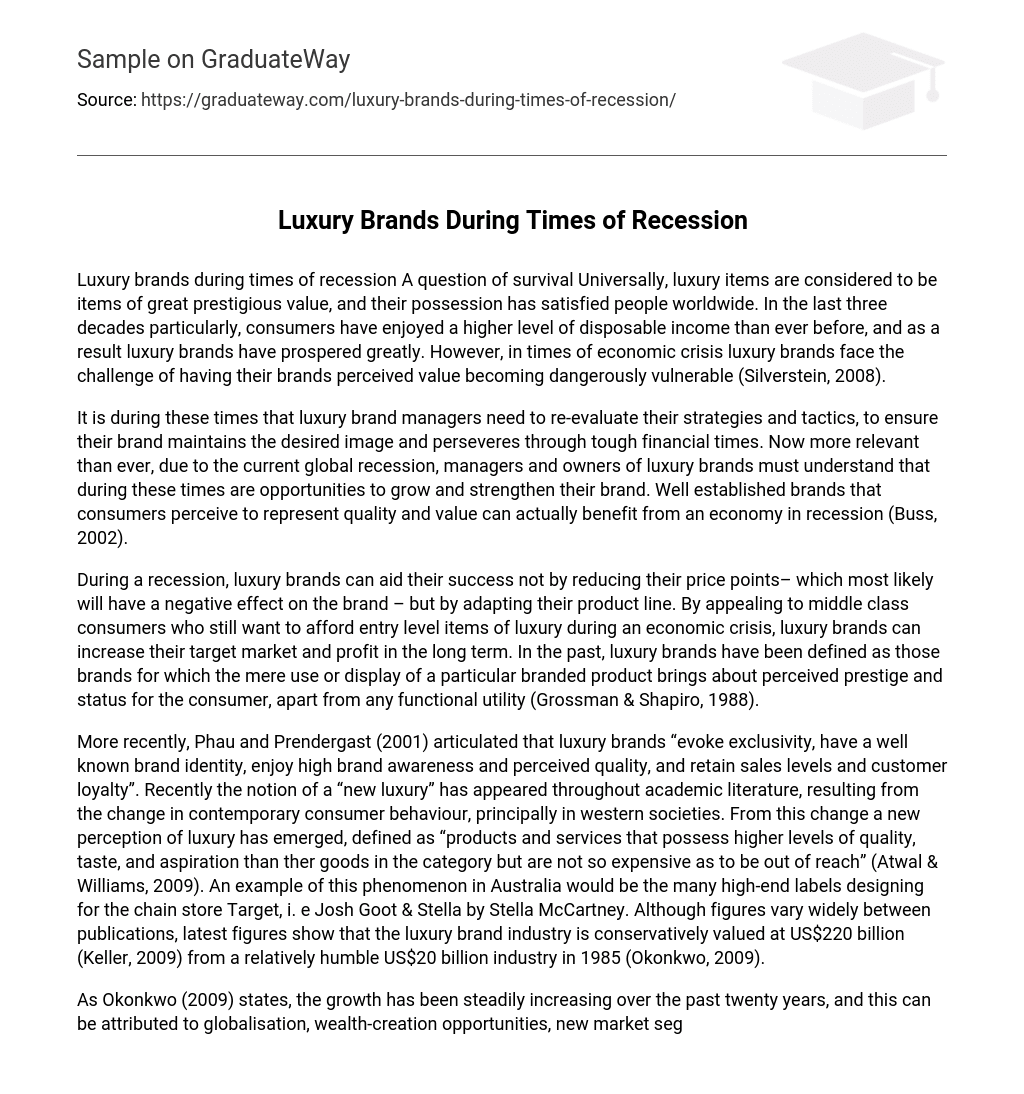Luxury brands during times of recession A question of survival Universally, luxury items are considered to be items of great prestigious value, and their possession has satisfied people worldwide. In the last three decades particularly, consumers have enjoyed a higher level of disposable income than ever before, and as a result luxury brands have prospered greatly. However, in times of economic crisis luxury brands face the challenge of having their brands perceived value becoming dangerously vulnerable (Silverstein, 2008).
It is during these times that luxury brand managers need to re-evaluate their strategies and tactics, to ensure their brand maintains the desired image and perseveres through tough financial times. Now more relevant than ever, due to the current global recession, managers and owners of luxury brands must understand that during these times are opportunities to grow and strengthen their brand. Well established brands that consumers perceive to represent quality and value can actually benefit from an economy in recession (Buss, 2002).
During a recession, luxury brands can aid their success not by reducing their price points– which most likely will have a negative effect on the brand – but by adapting their product line. By appealing to middle class consumers who still want to afford entry level items of luxury during an economic crisis, luxury brands can increase their target market and profit in the long term. In the past, luxury brands have been defined as those brands for which the mere use or display of a particular branded product brings about perceived prestige and status for the consumer, apart from any functional utility (Grossman & Shapiro, 1988).
More recently, Phau and Prendergast (2001) articulated that luxury brands “evoke exclusivity, have a well known brand identity, enjoy high brand awareness and perceived quality, and retain sales levels and customer loyalty”. Recently the notion of a “new luxury” has appeared throughout academic literature, resulting from the change in contemporary consumer behaviour, principally in western societies. From this change a new perception of luxury has emerged, defined as “products and services that possess higher levels of quality, taste, and aspiration than ther goods in the category but are not so expensive as to be out of reach” (Atwal & Williams, 2009). An example of this phenomenon in Australia would be the many high-end labels designing for the chain store Target, i. e Josh Goot & Stella by Stella McCartney. Although figures vary widely between publications, latest figures show that the luxury brand industry is conservatively valued at US$220 billion (Keller, 2009) from a relatively humble US$20 billion industry in 1985 (Okonkwo, 2009).
As Okonkwo (2009) states, the growth has been steadily increasing over the past twenty years, and this can be attributed to globalisation, wealth-creation opportunities, new market segments, digital communications, international travel and culture convergence. Also, in recent years there has been a significant shift in the consumption of luxury goods, with unprecedented demand coming from Asian countries. In view of that fact, more and more research is being conducted into the cross cultural comparisons of attitudes toward the luxury concept (Husic & Cisic, 2008).
Broken down into statistics, 37% of luxury goods are purchased in Asia, 35% in Europe, 24% in the USA and 4% in the rest of the world (Chadha and Husband, 2006). Luxury brands such as Rolex and Cartier were one of the first off the mark to embrace this development over recent years, leading the penetration of luxury goods into profitable regions such as China and Russia (Okonkwo, 2009). These new markets are changing the dynamics of the luxury brand landscape, and demand that luxury brand managers focus on simultaneously refining their existing practices, and continually evolving to meet the needs of the luxury brand market.
Keller (2009) illustrates that there are ten defining characteristics of luxury branding. These are depicted in Table 1 (see Appendix). Through these characteristics an understanding of how best to market luxury brands can be appreciated. Brand equity and brand architecture are particularly important as they can be manipulated to manage the challenge many luxury brands face, attracting new customers without alienating existing customers (Keller, 2009). One of the greatest challenges facing luxury branding today is the dilution of the brand image through vertical extensions (Mergen, et al 2009).
If a luxury brand continues to expand without restraint, it faces the consequence of tarnishing the perceived image of the brand in the mind of consumers. Gucci faced this problem in the 1980’s when its brand image had been damaged extensively, falling from the dizzying heights of being a fashion leader,only a decade before. At this point Gucci had over 22,000 items distributed evenly throughout all department stores, including items such as cheap canvas pocketbook covers which did not fit the label’s high end fashion image.
Sales only recovered after Gucci drastically downsized their range to 7000 items, all which reflected the labels desired image of status, elegance and quality. Now Gucci is the second highest selling high-end fashion label globally. (Keller, 2009) This example highlights how careless vertical brand extensions can seriously damage a luxury brand’s image, and how only by careful brand marketing strategies and time can it recover.





